#pre-raphaelite brother
Photo

James Bertrand
Christians removing the Bodies of Martyrs from the Tiber
Oil on cnvas, 97.2 x 147.3 cm, 19th century
#james bertrand#saint#martyr#first martyrs of the church of rome#19th century#nazarene movement#pre-raphaelites#pre-raphaelite brother
109 notes
·
View notes
Text

Valentine Cameron Prinsep (1838-1904)
"Cinderella" (c. 1899)
Oil on canvas
Pre-Raphaelite
Located in the Manchester Art Gallery, Manchester, England
#paintings#art#artwork#literary painting#female portrait#valentine cameron prinsep#oil on canvas#fine art#pre raphaelism#pre raphaelite#museum#english artist#british artist#cinderella#fairytale#brothers grimm#grimms fairy tales#grimms brothers#portrait of a girl#hearth#interior#1890s#late 1800s#late 19th century
863 notes
·
View notes
Text

The Labourers in the Vineyard (from the series The Parables of Our Lord and Saviour Jesus Christ), Brothers Dalziel after John Everett Millais, 1864
#art#art history#John Everett Millais#Brothers Dalziel#religious art#Biblical art#Christian art#Christianity#New Testament#Gospels#Parables of Christ#Pre-Raphaelite#Pre-Raphaelite Brotherhood#pre-raphaelisme#British art#English art#19th century art#Victorian period#Victorian art#engraving#wood engraving#Metropolitan Museum of Art
76 notes
·
View notes
Text

Arthur Hugues - At the Back of the North Wind (I am afraid of falling down there)
5 notes
·
View notes
Photo

a painting of two women sitting at a table in a room
#limbourg brothers#dream#Technical Scene#still life#Arts and Crafts Movement#creepy#screenshot#Pre-Raphaelite#painting#Anglo Gothic#surreal#illustration#retro#beautiful#infiniteartmachine#unreality
1 note
·
View note
Text
I forgot Algernon Charles Swinburne was a redhead. Tbh good for him.
#his friendship w lizzie siddal was an unexpected delight to read about in the pre-raphaelite sisterhood#jan marsh only brought it up to tell a story about when a bunch of them went to the theater and a little boy handing out programs#was scared of the two redheads sitting on both ends of the row and exclaimed 'theyre multiplying!!!'#oh to be in 1860s england where my hair color can scare a little boy#tales from diana#where is my redheaded male bestie?#growing up i had a neighbor w red hair whom i was in the same class w for grades 1-4#and i had kaily and he had two little redheaded brothers so the ppl on our bus called our street the red street#haven't spoken to him in years tho#anyway. in the prsh i got to the section yesterday where lizzie died :^( i was very sad#knew it was coming of course but then it was just like oh it's over. she's gone.#i love her so much she was such a delightful personality to read about#so many parts i need to go back and quote so i can save them on my blog before i have 2 return this book 2 the library#def. one of my favorite redheads. to quote anne sexton 'i am of her kind'
1 note
·
View note
Text
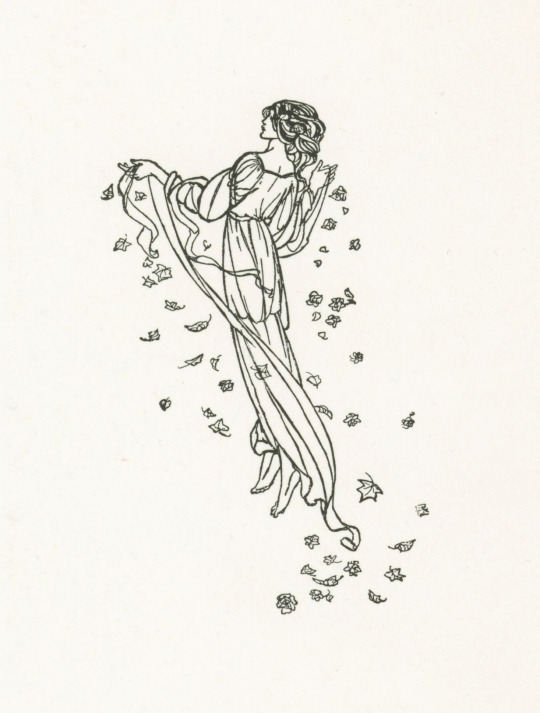
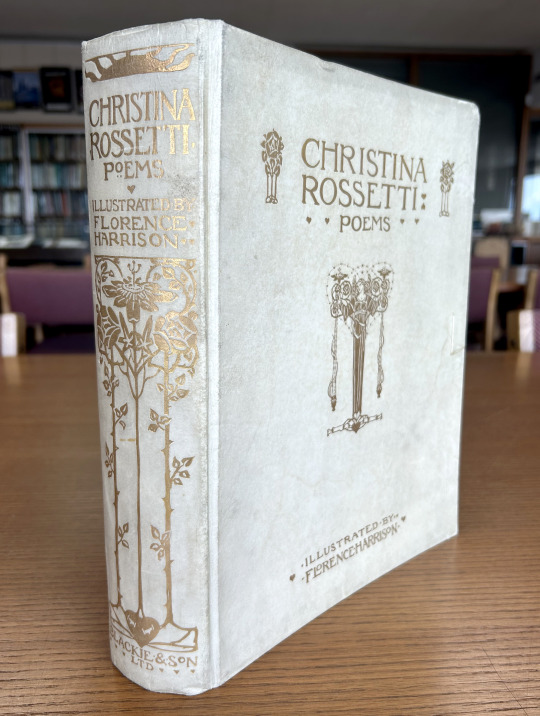

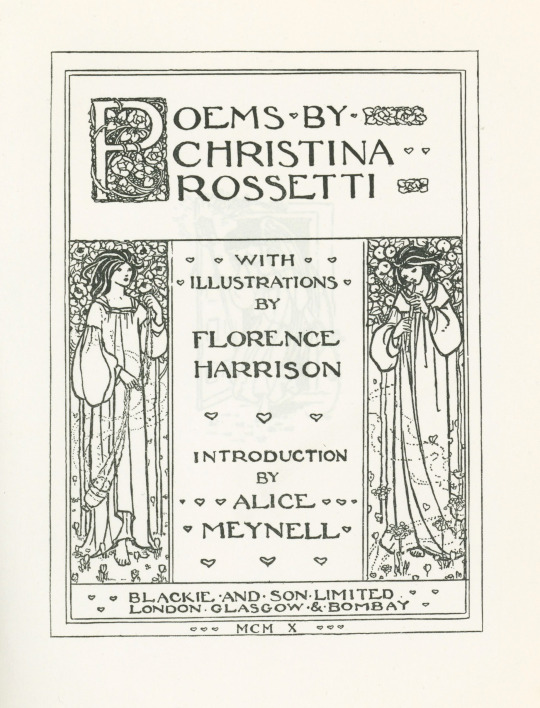




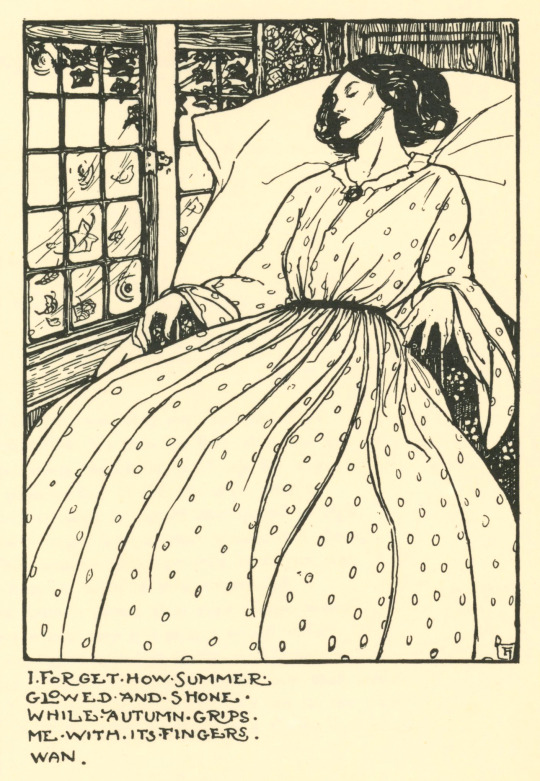

It’s Fine Press Friday!
Today we’re leaning into the drama with a 1910 edition of Poems from notorious bohemian and (unofficial) Pre-Raphaelite Brotherhood (PRB) member Christina Rossetti (1830-1894). This vellum covered, gilt stamped, 369-page tome was printed on Unbleached Arnold paper by the Villafield Press in Glasgow and published in limited run of 350 copies in London by Blackie & Son under the art direction of Talwin Morris. It features a praiseful yet cutting introduction from fellow poet, critic, and suffragist Alice Meynell (1847-1922) along with a wealth of illustrations (70 plates) by Florence Harrison (1877–1955) , an Australian illustrator of poetry and children’s books who worked extensively with Blackie & Son. Harrison’s style was inspired by the Romantic Era and the nature-worshipping, hedonistic values of the Art Nouveau and Pre-Raphaelite movements of the time. Fittingly, she also illustrated the works of fellow PRB poets William Morris (1834-1896) and Alfred Tennyson (1809-1892).
While many of the poems included are overtly devotional and express themes of purity, motifs of romantic love, limerence, melancholy, and death permeate the mood of the text as a whole. The Rossetti family, particularly Christina’s brother Dante Gabriel Rossetti (1828-1882) (poet, illustrator, painter, translator, and co-founder of the PRB) and Elizabeth Siddal (1829-1862) (artist, iconic art model, poet, and Dante’s longtime partner, muse, and eventual wife), are known for their exploits, excesses, creative legacy and influence on the culture of the era. Christina published her first poem at only 16, and Siddal posed for Millais's Ophelia at 19. The radical, passionate nature of the philosophies and lifestyle they embodied was as much a product of the intensity and privilege of their youth as of the Renaissance ideals and Victorian mores they rebelled against.
For a deeper dive on the Rossettis and their generation, check out this recent exhibition at the Tate Modern.
View another Christina Rossetti post
View another Dante Gabriel Rossetti post
View another Pre-Raphaelite post
View more Art Nouveau posts
--Ana, Special Collections Graduate Intern
#pre raphaelite#Christina Rossetti#Villafield Press#Blackie and Son#Blackie & Son#Dante Gabriel Rossetti#Pre Raphaelite Brotherhood#Romanticism#poetry#fine press#Unbleached Arnold paper#Alice Meynell#Florence Harrison#Elizabeth Siddal#limerence#bohemian#Talwin Morris#fine press fridays#Ana
169 notes
·
View notes
Text
MO GUAN SHAN IS A PRE-RAPHAELITE WOMAN

I just had a revelation.
I was just analyzing how future Mo dresses up so prettily.
We always knew he was handsome, since he was asked to model, but never realized how much. And of course He Tian is such a rich bastard who loves pretty things. And I think that Mo has always been aware and quite scared of being the "trophy wife" for rich He Tian.
But in the future he seems to kinda accept his beauty and grew accustomized to it, almost playing with it. He KNOWS he is handsome and he takes advantage of it.
At first to me it seemed like he kinda accepted his fate to be the trophy wife, but knowing him he would have looked defeated by this, but he seems so natural and smug with this shit that this cannot be a coincidence, he totally is a famme fatale who enjoys giving jealous He Tian an hard time.
But his future famme fatale behaviour made me realize one thing... Mo is beautiful, tall, with pale skin, red hair, scarlet lips, sharp features and melancholic expressions. And you know who this adjectives describes? Those willowy pre-raphaelite women. And you know what pre-raphaelite women do? They LURE men by making them falling in love and then they DESTROY them. I'm not saying that Mo will murder He Tian, maybe he will figuratively kill some aspect of him.
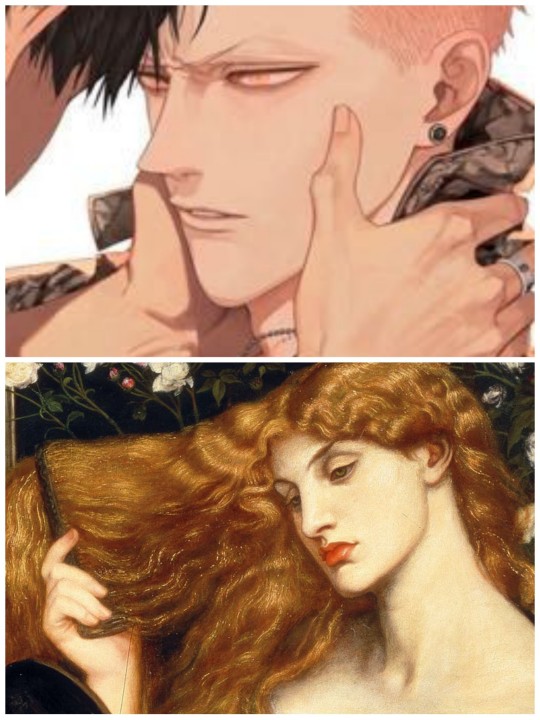
But he just exude this fucking powerful aura and we can totally see how much he is in charge in the TianShan dynamic. He EMPOWERS He Tian, and He Tian cannot do more than to fall limp in his charms like putty in Mo's hands.
Mo canonically is like those "fallen woman" (who, for the majority of time, were witches, mistresses or low-ranking swindlers) those female models were uneducated and from the working-class but bolder and more self-assured than their high-class equivalent.
But the most interesting thing to me is that we can see He Tian not as the victim of the famme fatale who is being toyed with, but as the artist himself. He is just like those young bold artist that protest against respectable and well-established rules of propriety and elegance with angry irriverence. Just to annoy others he loves to shock the respectable and bigott high-ranking society with someone they have absolutely no power amd control on (just as much as He Tian has none either) And not only he makes a use of Mo's rebellious presence, but he let Mo thrive in it, he helps him cultivate it. He basks in his nutricious vitality because it's his form of escapism from his boring life, where he is forced to work for his brother and oblige to the strict ambient.
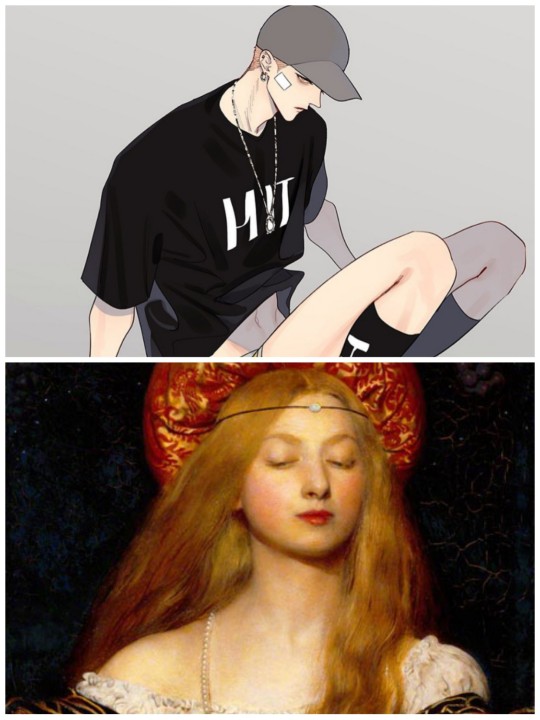
I think that I will make a more specific analysis about Mo as some specific pre-raphaelite women like Ophelia or La Belle Dame sans Merci.
#19 days#he tian#mo guan shan#tianshan#old xian#19天#19days#pre raphaelism#19 days old xian#19 days update
286 notes
·
View notes
Text


Peter in Narnia
Similar to Edmund's Narnia "knight" outfit, but with more layers/more reds. I don't have a lot to say about these, it's not really about real armor or chainmail and more about how pre-raphaelites used/faked the aesthetics of medieval knights in their paintings. Aka I didn't feel like drawing armor and chainmail so this is the 'pre-war' look for the Pevensie brothers XD.
I am the artist!!! Don’t repost without permission & credit! Thank you! Come visit me over on: https://instagram.com/ellen.artistic
(when I opened these up to edit something the links reverted to whatever this is XD)
#peter pevensie#the chronicles of narnia#narnia#the pevensies#historical costuming#historical fashion#redesigning book characters#the lion the witch and the wardrobe#tltwatw#character design#classic books#book art#digital illustraion#art blog#redesigning heroes#king peter the magnificent#kings and queens of narnia
407 notes
·
View notes
Text
I'm kinda losing steam, so have the first part of this. (Also, I've been working on this for over a month. I need some encouragement T-T)
The Once and Future Queen
Pre-Raphaelite!Konig/female model(?)!reader, 2.9k words
Warnings: (Likely) Historical innaccuracies, pretension, Dante Gabriel Rosetti slander (aka: accurately describing what he did), TF141 are here with bells on.
Reader notes: Light enough to be easily lifted by Soap, has a family, lives somewhere in England, working class, Victorian.
Part I: Walpurgia's Night
König was not a poet.
Neither in his native German, nor this bizarre tongue that felt like speaking three at once.
He was a man of few words, it only made sense to him that those words be simple and straight to the point. This attitude only made his fellows in the Brotherhood look upon him with rather some disdain.
With this he was fine, he wasn’t there to mince pretty words and use them to entice young women to fulfil his whims and stroke his ego.
The whole concept of poetry was a rather strange one to him to begin with. It seemed too prone to misrepresentations to his mind.
After all, one could not scream a painting of a lover’s embrace, or softly whisper a woodcut of a bloody battle. A bold statue of a conquering hero could not be turned dreadful by a tone of voice or a stuttering delivery.
No matter how honest the poet, the reader could turn their words to lie in another voice. Be that spoken aloud or just within their own mind.
It was a folly, he would say if asked. In a particularly thunderous mood he would claim it made men mad. Drove their confidence into levels that tipped straight over the precipice of insanity. That otherwise merely passionate men were made Narcissus with the products of their souls. Or worse, made monsters.
He had stood there, at the side of a young, lost, woman’s grave. The earth there turned fresh despite her being buried there years ago.
Simple folly then seemed like madness, and his work thus changed.
The word of the Bard became ash in his mouth.
Smitten Juliets, sweet Cordelias and even poor Ophelias losing their glitter and shine. Becoming naught but shadows flickering at the limbus of his sight.
Never honest. Never real.
Thusly, he became a Nazarene.
Vicious Judiths, loyal Ruths and penitent Marys Magdalene became his bread and butter.
Until he recalled that these too were written in verse, and so the word of the Lord became as cinders.
An unguided man, he wandered this foreign land as lost and adrift as the island itself.
Perhaps it was a misunderstanding that brought him to this festival, but he was loathe to confess that he had wished to become drunk upon this Ale as he considered matters French, Roman and British for his work.
It was here he saw them, on the day of Pentecost that these English did call Whitsun.
In this place to the North, far from capitals both ancient and modern.
This dying breed, these men of Morris. Dancing with their bells and handkerchiefs and swords never meant for battle.
It captivated König.
Here was legend, myth and mimesis.
Representation of ancient truths without the lies of verse, except only —perhaps— to gild the lily.
He took his sketches of the five.
The leader with his distinctive hat and fashionable beard.
The man dressed in rich colours and shine, like a jewelled beetle.
The one with the swarthy skin and bearing of a grand thespian.
The fellow with the piercing eyes and head shaved like warriors from the far side of the ocean.
The largest of them, covered in darkness with a skull blacked upon his face.
The One Four One, the side was called.
The crowd laughed and clapped and cheered along to each of the dances, enraptured by this tradition that was petering out to its end.
How it was worth the scorn that König had heard his cosmopolitan brothers heap upon it, he did not know. To him, these men were like warriors without a battle to fight.
König was a draughtsman and a painter, so he drew and he painted.
Captured the likeness of these men and their dance. Portraits of them in their mismatched gear titled with their odd nicknames, no sillier than his own.
It kept him busy, back in his studio engulfed in smog and soot. Now become home as well, for Morris men were far from fashionable amongst his former patrons.
The Earth had nearly completed her circuit ‘round the blazing Sun when he received a letter from the man that the side called captain.
They were planning to travel to a new village for the next Whitsun, and König was welcome to meet them there. Price would arrive first, then Soap and Ghost, and trailing along would be Gaz and Roach
He was rather confused that the invitation requested he join them in late April, as Whitsun would not be for weeks to come.
He said as much when he accepted their kind invitation, expressing that he would be honoured to join them.
A simple note was the only response he received as he packed up his meagre home .
‘The crowning of the May Queen must be honoured.’
Another of these strange island customs.
He pictured an austere woman in the fullness of life, tall for her sex and as imposing as Demeter while she ruled the growing season.
König sketched such things as he travelled by train and then coach and then buggy to a new village.
Was this queen special? he wondered. The ur-queen of life and growth, perhaps. So important that the near last of the Morris must attend her coronation.
He near vibrated with intrigue at the thought.
Here would be true magic and mystery, unsullied by the madness of verse.
Price met him at the village’s inn, on the day of his arrival, buying him a drink and then a plate of food after passing his gaze up and down the near starving artist.
He muttered something under his breath about brotherhood, it dripped with such disdain that König did fear it might land in his ale.
After, Price perked up.
“You’ll enjoy this,” he promised.
Any wondering König might have done about how they would fill the time until May Day was quashed by the villagers. After all, surely a large man like him was there to help.
He had no heart to say no, and was press ganged into helping them.
On the third day, his job was to help erect a pole festooned with ribbons.
This was where Soap and Ghost found him. One large man became two, their third securing the pole so well that naught but the mightiest gale could bring it down.
After each day of hard work the villagers fed and watered them well. Women presenting them with stews and puddings, men with bread and ale, the children with wild berries and juices.
The three men of the side ate well, reminding König to as well when he became too absorbed in his sketching of the day’s events.
On one occasion, Ghost and Price caught him by the arms, Soap taking his papers and charcoal, refusing to return them until he cleared his plate.
He almost snarled, but the gnawing pain that had settled into his gut asserted itself and cut him off.
Soap laughed and he and his comrades watched, quietly pleased as König ate.
He was not a Morris man, but he felt like one in the waning days of the month. Working, feasting and resting together.
He wondered if this would last, if he was merely an understudy for their absent members. Standing in their spot, keeping their mark ready until they could arrive.
This uncertainty lasted until the twilight of Walpurgia’s night, the last sunset before the queen was crowned, when the quintuplet once again became whole.
Pulled along like the sea, König followed the moon of the three to the place where buggies made their stop.
He sat on the bench and kept watch for them as they passed the time with practice. It was difficult for him to maintain his vigil, fascinated by how they danced as though nothing were missing at all. The glint of their blades and shadows of Roach and Gaz danced as much as they did in the golden hour.
Only the distant sound of horses kept him from putting the image to paper.
Hoofbeats blended with the stomp of the rappers into one melodious tune.
König watched as two figures leapt from the buggy, running at full pelt down the road. The sound of their steps and laughter joined the steady rhythm until they slipped into the dance, replacing shadows like they were always there.
It was as the buggy drew to a halt that he realised that there was no absence for him to fill.
A woman’s laugh rose from the buggy, drawing five wide smiles and a curious look.
Gilded by the setting sun, she stood above them all —even Ghost and König — glorious like a queen.
This must be her, the monarch of May. Surely she was who the One Four One came to honour, bringing with them a foreign pretence of a king to make record of the ceremony.
She was not Demeter, far too soft and kind as Soap lifted her by the waist from the buggy, dancing them into a spin before setting her to the ground.
Immediately she was surrounded and towered over, the side as her court and her court at her side.
“And so the summer queen arrives,” Price greeted, laughter in his voice as he doffed his hat into a deep bow.
It was a wry grin she shot back, curtseying low.
“Of course Captain, this is not an occasion that one could afford to miss.”
She turned her eyes to König, lit ablaze as the stars crept out to shine.
“And who might this be?” she asked, looking him up and down as one might a castle.
“A sixth for a five man band? Why, was including Ghost not challenge enough?”
The man himself huffed.
“Her majesty jests,” Soap declared with a conspiratorial grin. “T’was no issue with Ghost at all. Excepting, of course, his demeanour.”
That earned the Scot a cuff around the head that hurt not at all, if his wide smile bore fair witness.
Price beckoned König over.
“To honour the occasion, we invited a titled man to oversee proceedings. A majesty in his own right.”
A hand fell on his shoulder.
“A delight, my queen, to present to you a king; König.”
Those eyes flew wide, and pretty lips parted in a gasp, before she curtseyed low again..
“Nothing but a pleasure, I’m sure,” she smiled, so beautiful that it made his hands twitch. “To meet you is like a gift from above.”
She wore admiration on her face like another lady might wear powder and rouge.
“You know my work,” he realised.
“Yes. I had the pleasure of seeing it as I attended my lady during a trip to the city.”
The smile she wore was enchanting, almost enough that he didn’t parse what she said. Almost.
“Your lady?”
“Away from here I’m a mere lady’s maid.”
“A poet,” Gaz corrected, “one who pays for room and board by masquerading as a maid.”
She gave him a look that seemed to sigh ‘not you too’.
König’s heart fell to his feet.
“Not much of one,” she murmured, looking up at him, embarrassed.
“Tosh.”
Ghost’s simple comment brought a smile back to the queen’s face. She tugged his shirt to draw him down for a kiss on the cheek.
König watched them. He wondered how much of the platonic nature of her affection was pure falsehood. How deep could the lies of verse go?
Price’s hand fell again onto his shoulder, the look in the man’s eyes somehow both concerned and warning in the same expression.
“We’ll get your bags to your Mam’s and then circle back to the pub, hmm?” he said to her, hand tightening on the painter’s shoulder.
König found himself almost frogmarched into helping as the others, including their queen, unloaded the buggy of bags and cases.
“Later,” was the captain’s quiet warning.
The Morris men and their queen conversed with bright smiles and open laughter.
Even the taciturn spectre was light. He shared a story with the newcomers of how one girl (soft and kind with a sweet, dark, face) commandeered he and König to help her pick some upstart elderflowers. She’d sat on Ghost’s shoulders to reach blooms to pluck alongside König. A little princess who crowned them both in flowers and thanks.
Gaz puffed up in pride when König called her a braves Mädchen.
“Just wait until tomorrow. You’ll see her be really brave.”
To a man, the One Four One nodded in agreement.
“I just hope I can do her justice,” the queen sighed.
Roach patted her on the back with a reassuring grin. The silent conversation between them enough to draw her shoulders back.
“You’re right. Just… one more pass?”
He laughed, it running through the group like a plague. Affecting even König through his veil of misery.
He didn’t speak much, even as they made their efforts to include him in the conversation as though nothing were amiss. To them, he supposed, there was not.
He was no fool. He was aware that to educated and uneducated men alike, his aversion to poetry was bizarre.
The expression colouring Price’s countenance told him as much when the queen went into her family home to put away her bag and be smothered in love.
König told him that he could not stand that which would disturb the grave of a young woman as she slept eternal.
He had expected confusion, perhaps more scorn, but instead he was given sympathy.
Soap put his hand on König’s arm.
A frisson of disgust ran through the side.
“We heard about that,” Price rumbled, “foul business.”
“Were you friends?” A question asked by all, but spoken by Gaz.
He threw his thoughts back to her gentle face and broken soul. They spoke as infrequently as they met. Even as she sat for him, but those silences were amicable. Amicable.
“Ja.”
Delusion as it may be, she and he were kindred spirits. This he knew in his heart.
“I get how you feel,” Soap commiserated, “that guy’s a cunt.”
It began slowly and then came out of his like a torrent. Chuckle into raucous laughter.
How direct. How clear. How unpoetic.
It was like a veil had been lifted.
The defiler wasn’t a tortured poet, a grieving husband, Alighieri descending into hell.
“He is a cunt,” König stated. “Ja. Only a cunt would do that.”
The hand on his arm turned into an encouraging clap.
“There you go. He’s a cunt. You gonna let a cunt like that ruin something for you?”
That was wha he’d been allowing, wasn’t it?”
“No. Not anymore.”
“Good man.”
They were swiftly joined by the queen and her family, familiar from about the village.
The queen mother made shooing motions at them.
“Get a shift on lads,. They won’t light the bonfire without the guest of honour!”
The side gave their greetings and the group headed onward.
The queen’s family was a curious bunch, asking questions about what everyone had been up to on their travels and an inordinate amount about König.
“So… I hear you’re a painter,” her father had begun.
“Ja. We’ve already had this conversation.”
“... Right. I just didn’t know you were that painter…”
The man awkwardly moved into interrogating Gaz with his wife.
Odd fellow, but not unlikable.
It was not an unpleasant walk, König found himself rather enjoying it. Somehow folded into another band without meaning to.
He stole glances at the queen as they went, the dark shadow washed away. His heart was for from repaired, but now he no longer needed to second guess her quite so much.
She fidgeted while he looked at her. Dutifully, he averted his gaze as he noticed each time.
No wonder she was the guest of honour; even in dusty travelling clothes she was wonderful.
He wondered if she would be willing to sit for him.
Soon enough they reached the inn.
The bonfire was small and rather hastily made. He didn’t doubt that they built much more impressive ones to burn traitors in effigy.
Gaz and Roach were hurried off to place their bags in the side’s room as the innkeeper strode up to the party.
“Ah, good. You’re here!”
König could have sworn his heart stopped when the man put a hand on his back.
“Light the bonfire so we can ward off the witches, then.”
He looked at the innkeeper, nonplussed.
The hand patted.
“Happy wall purge is knack, König,” the man grinned up at him. He looked so proud.
König nodded, a small smile playing on his own lips.
“Frohe Walpurgisnacht.”
He was handed a flaming torch and the gathered village folk cheered as the pile caught flame.
“From now on, we’ll know our May Queens will be safe from witches!” the innkeeper called to further cheers.
It was a strange feeling being the centre of attention like this, but it didn’t feel so unnatural as it should. Explaining the traditions of Walpurgisnacht to the queen and other curious souls wasn’t as harrowing as he’d have expected if told he’d be required to do so when he had arrived.
He expressed as much to Price as the bonfire died down and the side bade the queen and her family good night.
The captain shrugged and slapped him on the back.
“Sleep, it’s a big day tomorrow.”
19 notes
·
View notes
Note
I love how in the 1800s people painted Greek myths and idk what the style is called

Sleep and his His Half-Brother Death by John William Waterhouse in 1874
Tf ay this style called because I LOVE IT
Well, Waterhouse is a pre-raphaelite, and pre-raphaelites had their own distinct style.
Different artistic movements had paintings of ancient greek mythology subjects in the 1800s, neoclassicism and romanticism mostly.
I definitely recommend looking up what style each painting you like is, on google or whatever, it's very quick to do and can lead you to discovering even more cool art if you look into the rest of the artist's work or at similar artists.
15 notes
·
View notes
Photo

John Melhuish Strudwick
St. Cecilia
Oil on canvas, 1897
106 notes
·
View notes
Text
Emma Sandys • 1841 – 1877
British Pre-Raphaelite painter
Like many talented women painters, there's not much known about Emma Sandys. Her brother, Frederick Sandys (1829-1904), was a well known member of the Pre-raphaelite Brotherhood. Emma's style can be said to have been influenced by her brother.
Though she didn't achieve the level of success her brother enjoyed, she exhibited her works in both London and Norwich between the years 1867 and 1874. Several of Emma Sandy's paintings were incorrectly attributed to her brother Frederick.
Emma died at the age of 36 from a "lung complaint".

Rosabelle • 1865
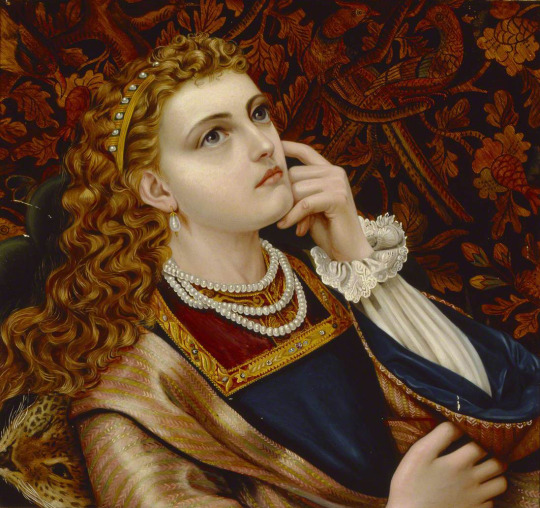
Elaine • 1862-65 • Oil on Panel • Norwich, Wightwick Manor, UK

Mary Emma Jones • 1874 • Oil on board • Private collection

Viola • c.1865–1877 • Walker Art Museum - Liverpool, England

Portrait Study of a Lady in a Yellow Dress • 1870 (Possibly a self-portrait)

A Young Female Musician • 1864 • Private collection
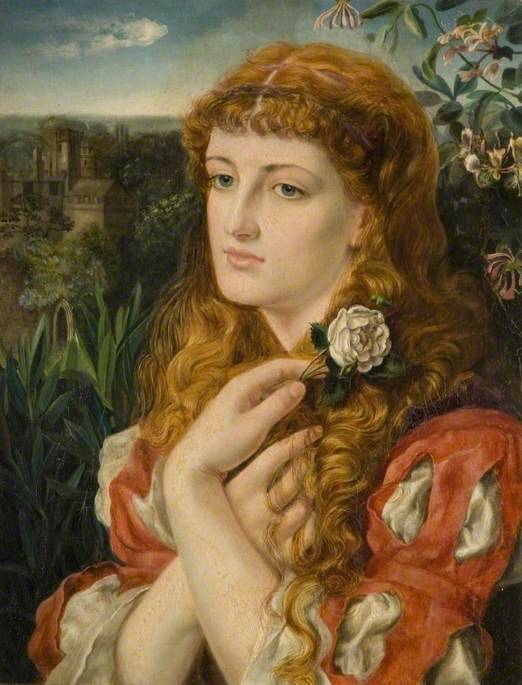
A Lady Holding a Rose • c.1870–1873 • Private collection
Source: artuk.org
A Medieval Beauty

A Medieval Beauty • c. 1875 • Unknown location
#emma sandys#pre raphaelism#fine art#art#painting#british art#19thcenturyart#pre raphaelie sisterhood#art history#british artist#women painters#paintings of women#frederick sandys
25 notes
·
View notes
Text

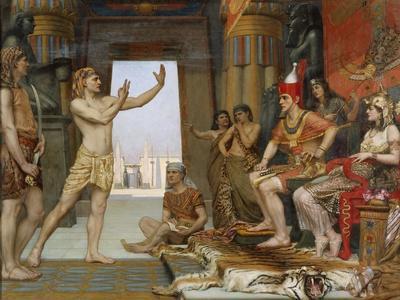



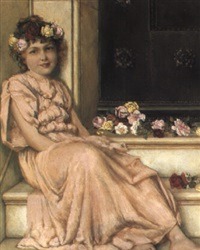


THE ART OF EXOTICISM BY REGINALD ARTHUR
Someone requested I look into REGINALD ARTHUR'S work and after some research I have something here, i had so much fun making this. REGINALD ARTHUR was a BRITISH painter who was active in the late 19th century. Not much is known about his early life or education, but records show that he was active as a painter between 1881 and 1896.
ARTHUR is best known for his dramatic historical paintings, particularly his depiction of the death of CLEOPATRA. His painting, titled "THE DEATH OF CLEOPATRA: THE STROKE OF DEATH," depicts the moment when CLEOPATRA takes her own life by allowing a venomous snake to bite her. The painting is a powerful and emotional portrayal of the tragic event, with CLEOPATRA shown in a state of agony and despair.
Aside from his painting of CLEOPATRA, Arthur also painted other historical scenes, such as 'JOSEPH INTERPRETING PHARAOH'S DREAM, 1893' and 'PHAROAH'S DAUGHTER, 1896.' He was known for his attention to detail and his ability to capture the emotions and drama of his subjects.
In 'JOSEPH INTERPRETING PHARAOH'S DREAM' The painting depicts the biblical story of Joseph, who was sold into slavery by his brothers and eventually rose to become a powerful advisor to the Pharaoh of Egypt. In the painting, Joseph is shown interpreting Pharaoh's dream of seven fat cows being devoured by seven skinny cows, foretelling seven years of plenty followed by seven years of famine.
ARTHUR'S style was heavily influenced by the PRE-RAPHAELITE MOVEMENT, with its focus on detailed and realistic depictions of historical and mythological scenes. He also incorporated elements of the Romantic style, with its emphasis on emotion and drama.
Despite his talent and success as a painter, little is known about ARTHUR'S personal life. It is believed that he may have lived and worked in LONDON, as some of his paintings depict scenes from the city.
Today, ARTHUR'S paintings are held in private collections and are highly sought after by art enthusiasts. His portrayal of CLEOPATRA'S death remains one of his most famous and enduring works, capturing the tragedy and drama of the event in a way that continues to captivate audiences.
6 notes
·
View notes
Photo

Sandro Botticelli
Primavera (c. 1480)
Tempera grassa on wood, 207 x 319 cm
The Uffizi Gallery, Florence
Highlights from around the web 💫
✨ Alessandro di Mariano di Vanni Filipepi (c. 1445 – 1510), known as Sandro Botticelli, was an Italian painter of the Early Renaissance. Botticelli's posthumous reputation suffered until the late 19th century, when he was rediscovered by the Pre-Raphaelites who stimulated a reappraisal of his work. Since then, his paintings have been seen to represent the linear grace of late Italian Gothic and some Early Renaissance painting, even though they date from the latter half of the Italian Renaissance period. [1]
✨ The nickname Botticelli, meaning "little barrel", derives from the nickname of Sandro's brother, Giovanni, who was called Botticello apparently because of his round stature. A document of 1470 refers to Sandro as "Sandro Mariano Botticelli", meaning that he had fully adopted the name. [2]
✨ This painting, usually known as the Primavera [or ‘Spring’] depicts nine figures from classic mythology advancing over a flowery lawn in a grove of orange and laurel trees. In the foreground, to the right, Zephyrus embraces a nymph named Chloris before taking her; she is then portrayed after her transformation into Flora, the spring goddess. The centre of the painting is dominated by the goddess of love and beauty, Venus, chastely dressed and set slightly back from the others, and by a blindfolded Cupid, firing his arrow of love. On the left, the three Graces, minor goddesses with virtues like those of Venus, are shown dancing in a circle. The composition is closed by Mercury, messenger of the Gods, recognisable from his helmet and winged sandals, as he touches a cloud with his staff. [3]
✨ Although the complex meaning of the composition remains a mystery, the painting is a celebration of love, peace, and prosperity. The dark colour of the vegetation is in part due to the aging process of the original pigment, but is lightened by the abundance of fruits and flowers. At least 138 species of different plants have been identified, all accurately portrayed by Botticelli, perhaps using herbaria. The attention to detail confirms the artist’s commitment to this piece, which is also evident in the sheer skill with which the paint has been applied. [4]
↪ Get this design on a t-shirt, sweatshirt, or notebook 🥀
#sandro botticelli#botticelli#primavera#spring#allegory of spring#italian art#florence#art history#dark academia#dark academia aesthetic#light academia#light academia aesthetic#green academia#academia aesthetic#art major#biography#fun facts#the more you know#mythology#venus
51 notes
·
View notes
Text
Explaining one of VTMB paintings (pt 3)
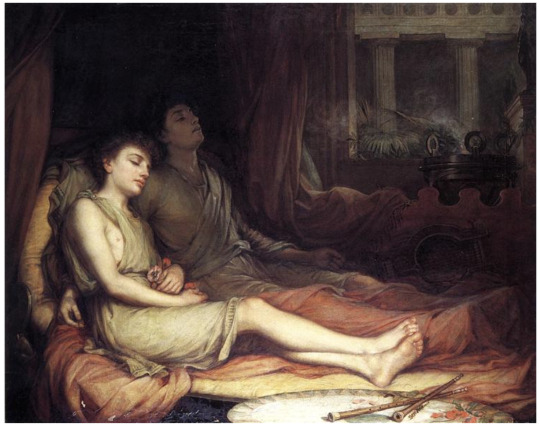
Sleep and His Half-Brother Death- 1874 Oil on canvas, by John William Waterhouse.
John William Waterhouse (6 April 1849 – 10 February 1917) was a English painter first known for his works painting in the Academic style before rejecting this and becoming part of the Pre-Raphaelite Brotherhood in 1883.
Sleep and His Half-Brother Death is notable as one of his early works still using the Academic style. This painting was Waterhouse's first Royal Academy exhibit, and it was painted after both his younger brothers died of tuberculosis* The painting itself is a reference to the Greek gods Hypnos (sleep) and Thanatos (death) who, in the Greek mythology, were brothers. Despite their similar poses in the painting, the character in the foreground is bathed in light, while his brother is shrouded in darkness; the first therefore represents Sleep, the latter Death. The personification of Sleep clasps poppies, symbolic of narcosis and dreamlike-states. This painting was first exhibited at the Royal Academy summer exhibition in 1874. and was such a well received success. [1]
In VTMB there are two interesting points. First, is that the artists brothers died of Consumptionit (tuberculosis), which up until the early 1800s deceased victims were sometimes though to come back to life as vampires. Bodies of those who had dies from tuberculosis were exhumed and internal organs ritually burned to stop the "vampire" from attacking the local population and to prevent the spread of the disease. [2] Secondly, sleep is the closest a Kindred can get to the peace without meeting their Final Death. Theres always lots of rumored over elders that have supposedly who have meet their Final Death that actually have chosen to go into a Sleep of Ages torpor. Sometimes in heavy, ostentatious and ominously decorated containers.(^ ‿ <) but don’t worry I hear there is a dedicated kindred out there separating fact from fiction owo.
Citations [1] Waterhouse, John William. “Sleep and His Half Brother Death, 1874 - John William Waterhouse .” Www.wikiart.org, 1 Jan. 1874, https://www.wikiart.org/en/john-william-waterhouse/sleep-and-his-half-brother-death-1874.
27 notes
·
View notes